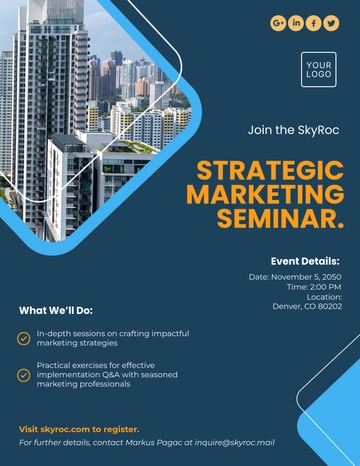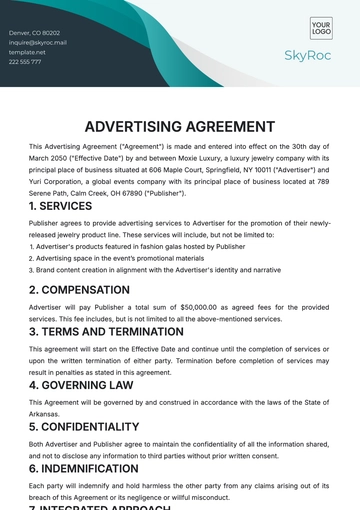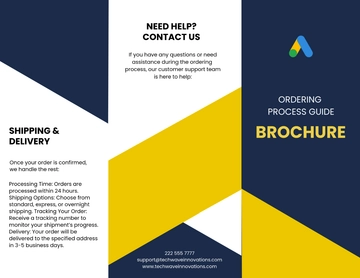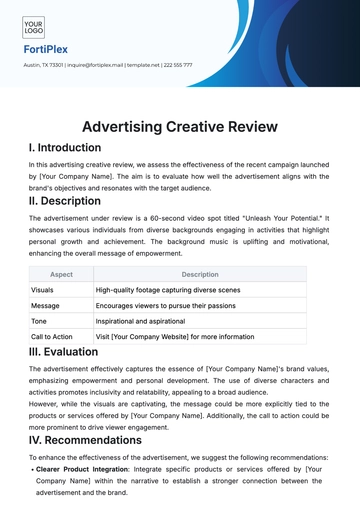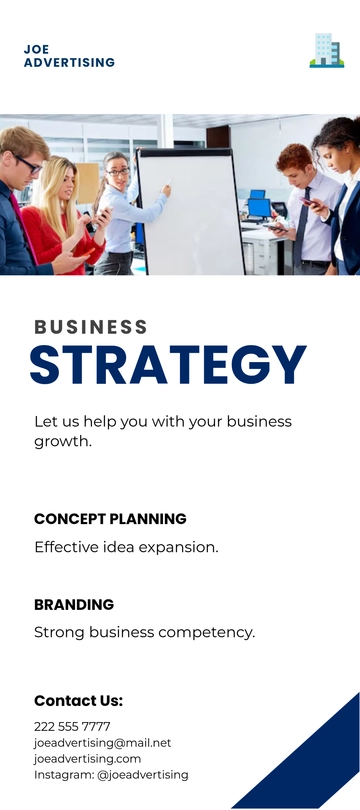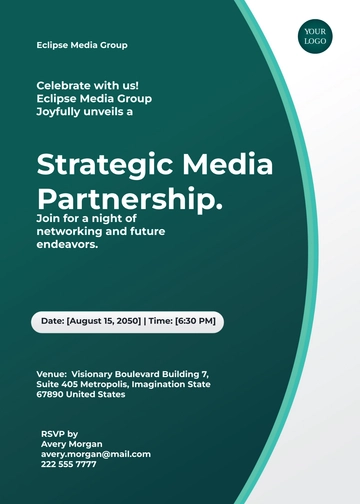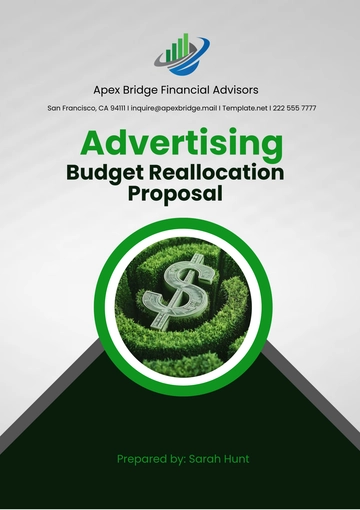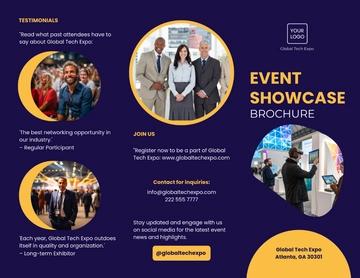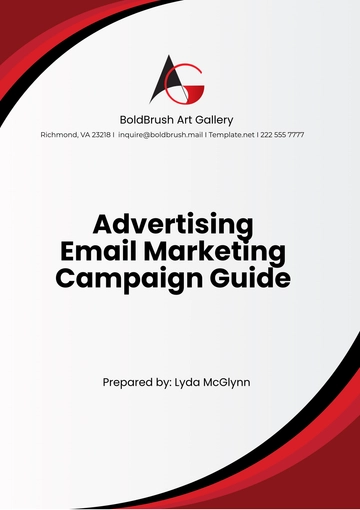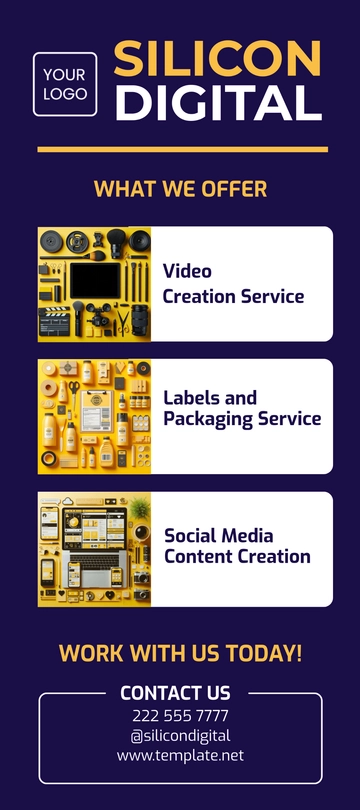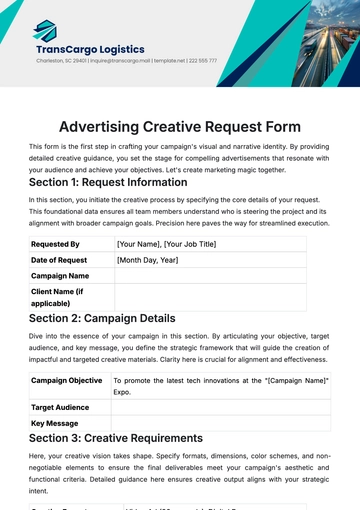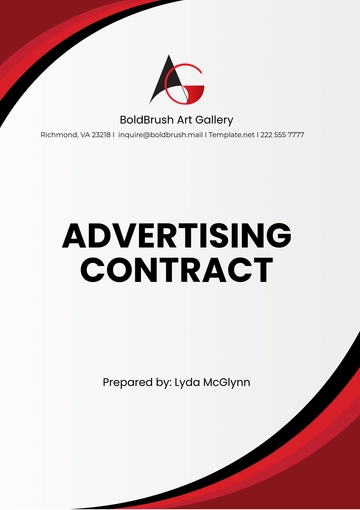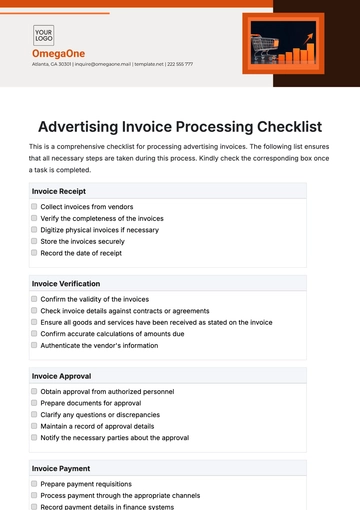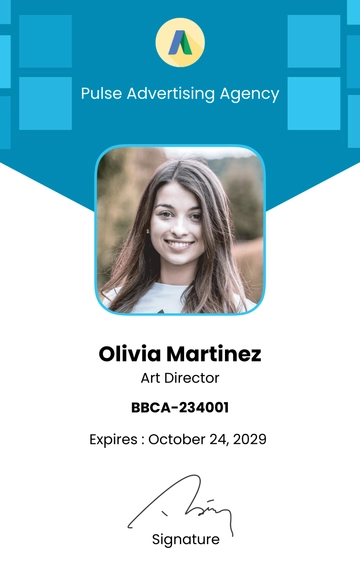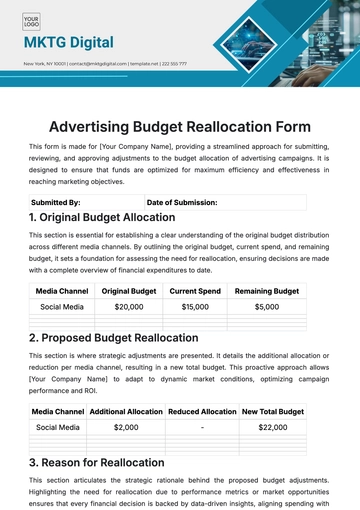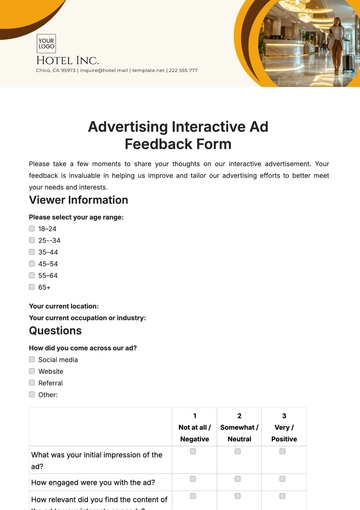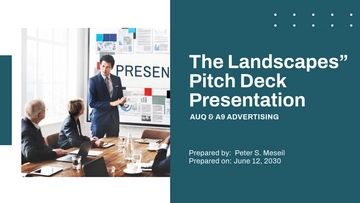Free Advertising Long-Term Media Buying Strategy
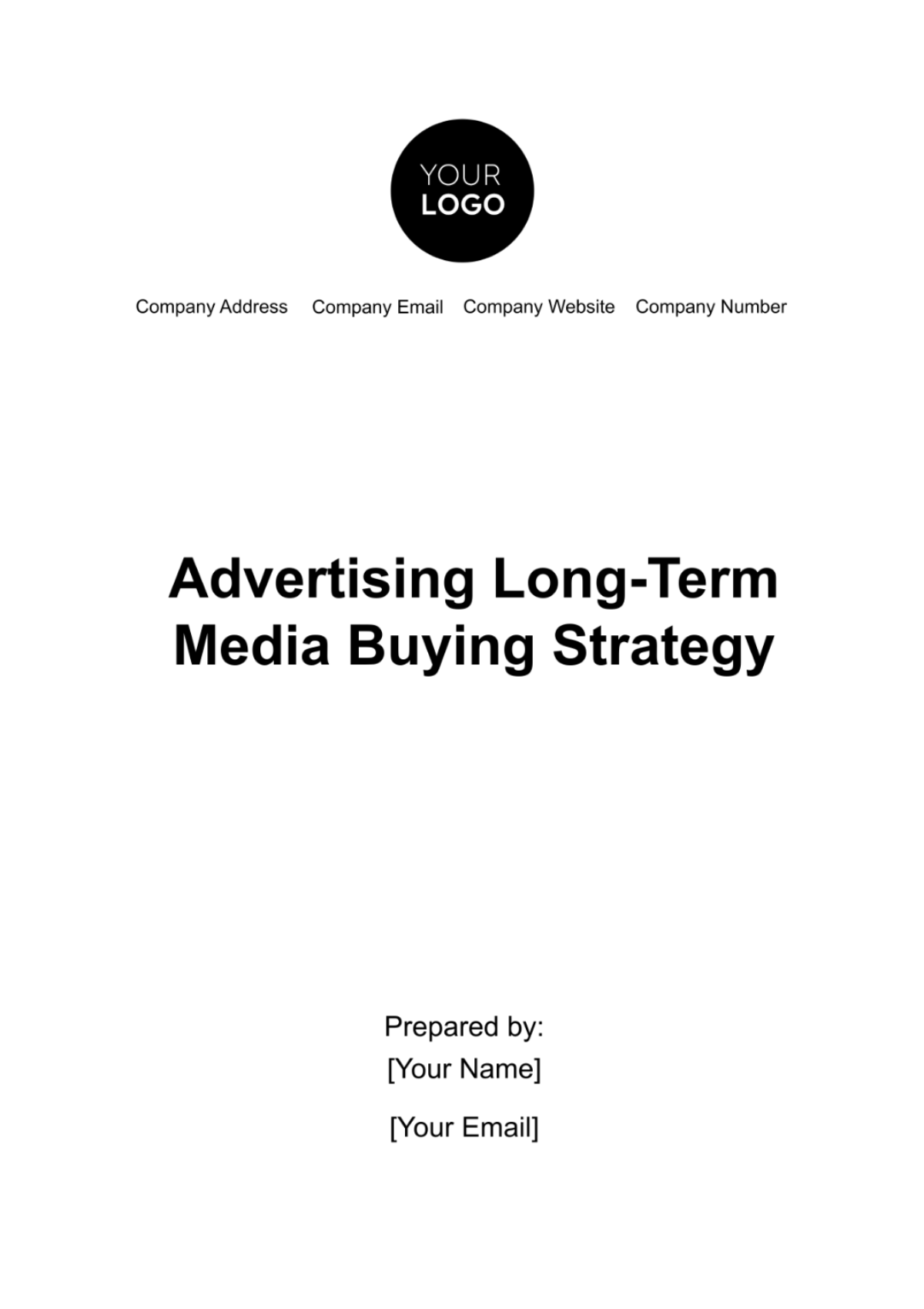
I. Executive Summary
This long-term media buying strategy is crafted to navigate [Your Company Name] through the dynamic industry of advertising, starting from the year [2050]. This strategy serves as a critical roadmap, guiding the company's advertising efforts to ensure sustained success and growth.
Staying agile and adaptive to emerging trends in media consumption entails keeping a pulse on the latest developments in advertising technology, consumer media habits, and industry best practices.
II. Strategic Objectives
Central to this strategy is the objective of maximizing Return on Investment (ROI). Recognizing the importance of financial prudence in advertising, the strategy emphasizes the allocation of resources in channels that offer the highest returns.
A. Maximize ROI Across Media Channels
Objective: To ensure that every dollar spent on media buying is an investment yielding maximum returns.
Approach: Utilize advanced analytics and big data to deeply understand the performance metrics of each media channel. This involves analyzing past campaign data, consumer response patterns, and market trends.
Expected Outcome: Enhanced efficiency in ad spend, leading to increased profitability and a stronger competitive position in the market.
B. Increase Audience Engagement
Objective: To create a deeper, more meaningful connection with the target audience through tailored content.
Approach: This objective will be achieved by developing a deep understanding of the audience's preferences, interests, and online behaviors. Engaging strategies will be designed, ranging from interactive digital experiences to emotionally resonant storytelling in traditional media.
Expected Outcome: Higher engagement rates leading to improved brand loyalty, customer retention, and ultimately, a stronger brand presence in the minds of the consumers.
C. Future-Proof Media Buying
Objective: To position [Your Company Name] as a forward-thinking leader in media buying by anticipating and adapting to future trends and technologies.
Approach: This will involve investing in cutting-edge technology and staying ahead of industry trends. Emphasis will be placed on predictive analytics, AI-driven market analysis, and adopting innovative media platforms like augmented reality or programmatic advertising.
Expected Outcome: By staying ahead of the curve, [Your Company Name] will not only mitigate risks associated with rapid industry changes but also capitalize on new opportunities, maintaining its leadership and relevance in the advertising sector.
Through these expanded strategic objectives, [Your Company Name] aims to not just navigate but excel in the complex and competitive world of media buying, ensuring long-term success and growth.
III. Media Buying Plan
[Your Company Name]’s Media Buying Plan is designed to put the company in a strategic position. Balancing traditional and digital media with the burgeoning opportunities offered by both platforms. The plan outlines a progressive shift in budget allocation across various media channels over the next five years which is outlined in the chart and table below:
Year | Television | Online | Social Media | Outdoor | |
2050 | 30% | 25% | 20% | 15% | 10% |
A. Gradual Shift from Traditional to Digital Media
Insight: This shift acknowledges the global trend towards digital consumption while recognizing the continuing relevance of traditional media. The plan proposes a gradual decrease in television and print media spend, paralleling the evolving media consumption habits of consumers.
Implementation: Funds will be reallocated from traditional to digital channels at a measured pace. This approach ensures a smooth transition, maintaining a strong presence in traditional media while progressively capitalizing on digital opportunities.
Expected Impact: By gradually shifting focus, [Your Company Name] aims to stay relevant to all segments of its audience - catering to those still engaged with traditional media while expanding its reach in the digital realm.
B. Increased Focus on Social Media Reflecting Consumer Trends
Insight: Social media's influence on consumer behavior and preferences is undeniable. This trend is particularly pronounced among younger demographics, who are critical to long-term brand growth and loyalty.
Implementation: Yearly increases in social media spend will be dedicated to platform diversification, content innovation, and influencer partnerships. The focus will be on interactive and engaging content that resonates with a digital-savvy audience.
Expected Impact: An increased allocation towards social media is anticipated to enhance direct engagement with consumers, build community, and foster brand advocacy, ultimately driving sales and brand loyalty.
C. Consistent Investment in Outdoor Advertising for Brand Visibility
Insight: Despite the digital shift, outdoor advertising remains a powerful tool for brand visibility and awareness, particularly in high-traffic urban areas.
Implementation: The plan maintains a steady investment in outdoor advertising. This includes digital billboards, transit advertising, and innovative outdoor media formats that capture audience attention in the physical world.
Expected Impact: Continuous investment in outdoor advertising will ensure consistent brand presence and recall in public spaces, complementing the digital and traditional media mix.
This Media Buying Plan is a balanced, dynamic strategy designed to navigate [Your Company Name] through the changing tides of media consumption. It is an adaptive blueprint, crafted to maximize the impact of every advertising dollar spent.
IV. Audience Engagement Strategy
Engaging with audiences is crucial and designed to captivate and resonate with our diverse audience across various media channels. This strategy sets clear engagement goals for each media channel over the next five years, adopting innovative tactics to enhance audience connection:
Year | Television | Online | Social Media | Outdoor | |
2050 | High | Medium | High | Low | Medium |
A. Interactive Content on Digital Platforms
Implementation: Develop engaging and interactive content such as polls, quizzes, augmented reality experiences, and live streaming sessions. This will be particularly emphasized on social media and online platforms.
Objective: To create a two-way communication channel, encouraging active participation and deeper immersion in the brand experience.
B. Data-Driven Content Customization
Implementation: Utilize advanced analytics and AI to gather insights into audience preferences and behaviors. Content will be tailored based on these insights, ensuring relevance and personalization.
Objective: To deliver content that resonates personally with each segment of the audience, thereby increasing engagement and loyalty.
C. Strategic Use of Influencers and Collaborations
Implementation: Partner with influencers and other brands that align with [Your Company Name]'s values and audience interests. These collaborations will span across digital and traditional media channels.
Objective: To leverage the credibility and reach of influencers and partners, thus broadening audience engagement and introducing the brand to new demographics.
D. Enhancing Storytelling in Traditional Media
Implementation: Despite a lower engagement goal for television and print, the focus will be on high-quality storytelling that conveys the brand's message in a compelling way.
Objective: To maintain brand consistency and appeal to audiences who prefer traditional media, ensuring they feel valued and engaged.
E. Innovative Outdoor Advertising Techniques
Implementation: Utilize dynamic digital billboards and interactive outdoor installations to capture attention and engage passersby.
Objective: To create memorable, visually captivating experiences that leave a lasting impression and enhance brand recall.
This approach recognizes the importance of evolving with consumer preferences and leveraging the strengths of each media channel to create a cohesive, engaging, and impactful brand presence.
V. Technological Integration
Technological Integration focuses on harnessing the power of advanced analytics and artificial intelligence (AI) to stay ahead in a rapidly evolving digital landscape. These tools will enable us to make more informed decisions, predict market trends, and understand our audience at a deeper level.
A. Implement Advanced Analytics for Real-Time Campaign Tracking
Implementation: Advanced analytics tools will be employed to monitor advertising campaigns in real time. This includes tracking key performance indicators (KPIs) like engagement rates, conversion rates, and overall campaign ROI.
Objective: The goal is to gain immediate insights into the performance of each campaign, allowing for swift adjustments and optimization. [Your Company Name] can ensure maximum efficiency and effectiveness of its advertising spend.
Expected Outcome: Enhanced agility in campaign management, leading to improved performance, reduced waste in advertising spend, and a more responsive advertising strategy.
B. Utilize AI for Predictive Modeling of Media Trends and Consumer Behavior
Implementation: AI technologies will be leveraged to analyze vast amounts of data, including market trends, consumer online behaviors, and media consumption patterns. This will enable predictive modeling, providing forecasts on future trends and consumer preferences.
Objective: The aim is to stay one step ahead of the market, anticipating changes and adapting strategies proactively. Predictive modeling will help in identifying emerging media channels and consumer trends before they become mainstream.
Expected Outcome: A proactive approach in media buying and content strategy, positioning [Your Company Name] as a forward-thinking leader in the advertising space.
These tools will provide invaluable insights and foresight, enabling the company to adapt quickly, optimize strategies, and maintain a competitive edge in the market.
VI. Risk Management
Effective risk management is crucial for the sustainability and success of [Your Company Name]'s media buying strategy. Here, we outline the proactive measures and strategies that will be implemented to mitigate potential risks, ensuring the company remains agile and resilient in the face of market fluctuations and industry disruptions.
A. Regularly Monitor Market Changes and Adjust Strategies Accordingly
Implementation: Establish a robust system for ongoing market surveillance, tracking changes in consumer behaviors, media consumption patterns, and emerging advertising trends.
Objective: The primary goal is to maintain a dynamic and flexible approach to media buying and campaign management. By staying informed of market shifts, [Your Company Name] can swiftly adapt its strategies to align with new realities, ensuring continued relevance and effectiveness.
Expected Outcome: Enhanced ability to anticipate and respond to market changes, minimizing the impact of external factors on the company's advertising effectiveness and ROI. This continual adaptation will help in maintaining a strong market position and avoiding potential losses from unforeseen market shifts.
B. Diversify Media Portfolio to Mitigate Risks Associated with Individual Channels
Implementation: Create a diversified media buying portfolio that spans a range of channels, including traditional, digital, and emerging platforms. This strategy will balance investments across different media types to avoid over-reliance on any single channel.
Objective: Reducing the impact of any downturns or disruptions in a particular channel. This approach also allows the company to capitalize on the unique strengths of each medium, ensuring a well-rounded and resilient advertising presence.
Expected Outcome: A more stable and secure advertising strategy that is less vulnerable to the volatility of individual media channels. This diversification will not only safeguard against market uncertainties but also provide a broader reach and greater flexibility in targeting diverse audience segments.
[Your Company Name] will have a good position to navigate the challenges of the advertising sector. By staying vigilant, adaptive, and diversified in its media buying approach, the company can effectively manage potential risks, ensuring steady progress towards its long-term advertising goals.
VII. Conclusion
This long-term media buying strategy positions [Your Company Name] to not only adapt to the changing media landscape but also to proactively shape its approach in line with emerging trends. By balancing traditional and digital media, focusing on audience engagement, and leveraging technology, the company is set to achieve sustained success in its advertising endeavors.
- 100% Customizable, free editor
- Access 1 Million+ Templates, photo’s & graphics
- Download or share as a template
- Click and replace photos, graphics, text, backgrounds
- Resize, crop, AI write & more
- Access advanced editor
Plan your long-term media buying strategy with less hassle with our Advertising Long-Term Media Buying Strategy Template! This fully editable and customizable strategy from Template.net ensures you capture every important detail. The AI Editor Tool makes editing intuitive, allowing you to create a comprehensive buying strategy! Access to get started!
